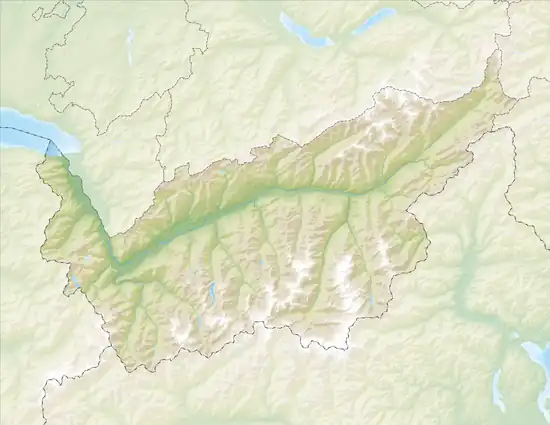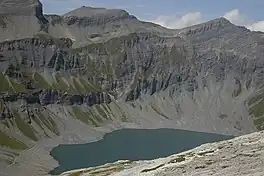Finhaut
Finhaut is a municipality in the district of Saint-Maurice in the canton of Valais in Switzerland.
Finhaut | |
|---|---|
 Finhaut village | |
 Coat of arms | |
Location of Finhaut | |
 Finhaut  Finhaut | |
| Coordinates: 46°5′N 6°58′E | |
| Country | Switzerland |
| Canton | Valais |
| District | Saint-Maurice |
| Government | |
| • Mayor | Andrea Ridolfi |
| Area | |
| • Total | 22.8 km2 (8.8 sq mi) |
| Elevation | 1,224 m (4,016 ft) |
| Population (31 December 2018)[2] | |
| • Total | 379 |
| • Density | 17/km2 (43/sq mi) |
| Time zone | UTC+01:00 (Central European Time) |
| • Summer (DST) | UTC+02:00 (Central European Summer Time) |
| Postal code(s) | 1925 |
| SFOS number | 6214 |
| Localities | Finhaut, Giétroz, Châtelard |
| Surrounded by | Salvan, Sixt-Fer-à-Cheval (FR-74), Trient, Vallorcine (FR-74) |
| Website | www SFSO statistics |
History
Finhaut is first mentioned in 1293 as Finyaux.[3]
Geography
Finhaut has an area, as of 2011, of 22.8 square kilometers (8.8 sq mi). Of this area, 3.2% is used for agricultural purposes, while 26.3% is forested. Of the rest of the land, 2.6% is settled (buildings or roads) and 67.8% is unproductive land.[4]
The municipality is located in the Saint-Maurice district, in the upper Trient valley on the French border. It consists of the village of Finhaut and the hamlets of Giétroz and Le Châtelard.
Lac d'Émosson is a reservoir (of the Émosson Dam) partially located in the municipality. The 17th stage of the 2016 Tour de France ended near the dam.
Coat of arms
The blazon of the municipal coat of arms is Gules, a Castle Argent embattled with three towers windowed Sable middle one roofed in chief two Arrows Or in saltire.[5]
Demographics

Finhaut has a population (as of December 2020) of 381.[6] As of 2008, 17.2% of the population are resident foreign nationals.[7] Over the last 10 years (2000–2010 ) the population has changed at a rate of 6.4%. It has changed at a rate of 12.2% due to migration and at a rate of 0% due to births and deaths.[4]
Most of the population (as of 2000) speaks French (308 or 96.9%) as their first language, German is the second most common (6 or 1.9%) and Italian is the third (2 or 0.6%).[8]
As of 2008, the population was 53.1% male and 46.9% female. The population was made up of 148 Swiss men (40.3% of the population) and 47 (12.8%) non-Swiss men. There were 143 Swiss women (39.0%) and 29 (7.9%) non-Swiss women.[9] Of the population in the municipality, 175 or about 55.0% were born in Finhaut and lived there in 2000. There were 52 or 16.4% who were born in the same canton, while 43 or 13.5% were born somewhere else in Switzerland, and 35 or 11.0% were born outside of Switzerland.[8]
As of 2000, children and teenagers (0–19 years old) make up 23.3% of the population, while adults (20–64 years old) make up 57.5% and seniors (over 64 years old) make up 19.2%.[4]
As of 2000, there were 134 people who were single and never married in the municipality. There were 144 married individuals, 28 widows or widowers and 12 individuals who are divorced.[8]
As of 2000, there were 130 private households in the municipality, and an average of 2.4 persons per household.[4] There were 46 households that consist of only one person and 11 households with five or more people. In 2000, a total of 129 apartments (34.9% of the total) were permanently occupied, while 172 apartments (46.5%) were seasonally occupied and 69 apartments (18.6%) were empty.[10] As of 2009, the construction rate of new housing units was 2.7 new units per 1000 residents.[4]
|
|
| ||||||||||||||||||||||||||||||||||||||||||||||||||||||||||||
| Source: [3][11] | ||||||||||||||||||||||||||||||||||||||||||||||||||||||||||||||
Sights
The entire Finhaut area is designated as part of the Inventory of Swiss Heritage Sites.[12]
Politics
In the 2007 federal election the most popular party was the CVP which received 55.09% of the vote. The next three most popular parties were the FDP (15.6%), the SP (13.14%) and the SVP (7.96%). In the federal election, a total of 183 votes were cast, and the voter turnout was 66.3%.[13]
In the 2009 Conseil d'État/Staatsrat election a total of 165 votes were cast, of which 8 or about 4.8% were invalid. The voter participation was 64.5%, which is much more than the cantonal average of 54.67%.[14] In the 2007 Swiss Council of States election a total of 178 votes were cast, of which 12 or about 6.7% were invalid. The voter participation was 65.4%, which is much more than the cantonal average of 59.88%.[15]
Economy
As of 2010, Finhaut had an unemployment rate of 2%. As of 2008, there were 7 people employed in the primary economic sector and about 3 businesses involved in this sector. No one was employed in the secondary sector. 106 people were employed in the tertiary sector, with 29 businesses in this sector.[4] There were 157 residents of the municipality who were employed in some capacity, of which females made up 40.1% of the workforce.
In 2008 the total number of full-time equivalent jobs was 80. The number of jobs in the primary sector was 2, all of which were in agriculture. There were no jobs in the secondary sector. The number of jobs in the tertiary sector was 78. In the tertiary sector; 9 or 11.5% were in wholesale or retail sales or the repair of motor vehicles, 24 or 30.8% were in the movement and storage of goods, 25 or 32.1% were in a hotel or restaurant, 1 was the insurance or financial industry, 4 or 5.1% were in education.[16]
In 2000, there were 28 workers who commuted into the municipality and 64 workers who commuted away. The municipality is a net exporter of workers, with about 2.3 workers leaving the municipality for every one entering.[17] Of the working population, 14.6% used public transportation to get to work, and 42.7% used a private car.[4]
Religion
From the 2000 census, 275 or 86.5% were Roman Catholic, while 14 or 4.4% belonged to the Swiss Reformed Church. 14 (or about 4.40% of the population) belonged to no church, are agnostic or atheist, and 15 individuals (or about 4.72% of the population) did not answer the question.[8]
Education
In Finhaut about 121 or (38.1%) of the population have completed non-mandatory upper secondary education, and 26 or (8.2%) have completed additional higher education (either university or a Fachhochschule). Of the 26 who completed tertiary schooling, 50.0% were Swiss men, 23.1% were Swiss women.[8]
As of 2000, there were 30 students in Finhaut who came from another municipality, while 24 residents attended schools outside the municipality.[17]
Transportation
The narrow-gauge Martigny–Châtelard line passes through the eastern edge of the municipality and has three stations: Finhaut, Le Châtelard VS, and Le Châtelard-Frontière.
References
- "Arealstatistik Standard - Gemeinden nach 4 Hauptbereichen". Federal Statistical Office. Retrieved 13 January 2019.
- "Ständige Wohnbevölkerung nach Staatsangehörigkeitskategorie Geschlecht und Gemeinde; Provisorische Jahresergebnisse; 2018". Federal Statistical Office. 9 April 2019. Retrieved 11 April 2019.
- Finhaut in German, French and Italian in the online Historical Dictionary of Switzerland.
- Swiss Federal Statistical Office Archived January 5, 2016, at the Wayback Machine accessed 21-September-2011
- Flags of the World.com accessed 21-September-2011
- "Ständige und nichtständige Wohnbevölkerung nach institutionellen Gliederungen, Geburtsort und Staatsangehörigkeit". bfs.admin.ch (in German). Swiss Federal Statistical Office - STAT-TAB. 31 December 2020. Retrieved 21 September 2021.
- Swiss Federal Statistical Office - Superweb database - Gemeinde Statistics 1981-2008 Archived June 28, 2010, at the Wayback Machine (in German) accessed 19 June 2010
- STAT-TAB Datenwürfel für Thema 40.3 - 2000 Archived April 9, 2014, at the Wayback Machine (in German) accessed 2 February 2011
- Ständige Wohnbevolkerung nach Geschlecht und Heimat am 31.12.2009.xls (in German and French) accessed 24 August 2011
- Swiss Federal Statistical Office STAT-TAB - Datenwürfel für Thema 09.2 - Gebäude und Wohnungen Archived September 7, 2014, at the Wayback Machine (in German) accessed 28 January 2011
- Swiss Federal Statistical Office STAT-TAB Bevölkerungsentwicklung nach Region, 1850-2000 Archived September 30, 2014, at the Wayback Machine (in German) accessed 29 January 2011
- "Kantonsliste A-Objekte". KGS Inventar (in German). Federal Office of Civil Protection. 2009. Archived from the original on 28 June 2010. Retrieved 25 April 2011.
- Swiss Federal Statistical Office, Nationalratswahlen 2007: Stärke der Parteien und Wahlbeteiligung, nach Gemeinden/Bezirk/Canton Archived May 14, 2015, at the Wayback Machine (in German) accessed 28 May 2010
- Staatsratswahlen vom 1. März 2009 (in German) accessed 24 August 2011
- Ständeratswahl 2007 (in German) accessed 24 August 2011
- Swiss Federal Statistical Office STAT-TAB Betriebszählung: Arbeitsstätten nach Gemeinde und NOGA 2008 (Abschnitte), Sektoren 1-3 Archived December 25, 2014, at the Wayback Machine (in German) accessed 28 January 2011
- Swiss Federal Statistical Office - Statweb (in German) accessed 24 June 2010
External links
- Official website (in French)
- Finhaut in German, French and Italian in the online Historical Dictionary of Switzerland.
